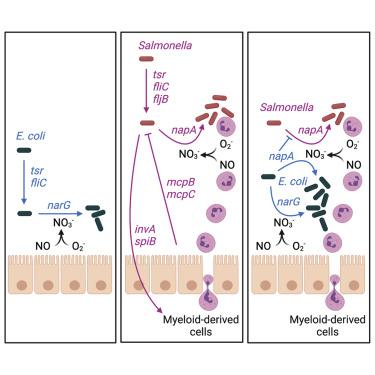Cell Host & Microbe ( IF 30.3 ) Pub Date : 2022-05-13 , DOI: 10.1016/j.chom.2022.04.012 Megan J Liou 1 , Brittany M Miller 1 , Yael Litvak 2 , Henry Nguyen 1 , Dean E Natwick 3 , Hannah P Savage 1 , Jordan A Rixon 4 , Scott P Mahan 1 , Hirotaka Hiyoshi 5 , Andrew W L Rogers 1 , Eric M Velazquez 1 , Brian P Butler 6 , Sean R Collins 3 , Stephen J McSorley 4 , Rasika M Harshey 7 , Mariana X Byndloss 8 , Scott I Simon 9 , Andreas J Bäumler 1

|
Changes in the microbiota composition are associated with many human diseases, but factors that govern strain abundance remain poorly defined. We show that a commensal Escherichia coli strain and a pathogenic Salmonella enterica serovar Typhimurium isolate both utilize nitrate for intestinal growth, but each accesses this resource in a distinct biogeographical niche. Commensal E. coli utilizes epithelial-derived nitrate, whereas nitrate in the niche occupied by S. Typhimurium is derived from phagocytic infiltrates. Surprisingly, avirulent S. Typhimurium was shown to be unable to utilize epithelial-derived nitrate because its chemotaxis receptors McpB and McpC exclude the pathogen from the niche occupied by E. coli. In contrast, E. coli invades the niche constructed by S. Typhimurium virulence factors and confers colonization resistance by competing for nitrate. Thus, nutrient niches are not defined solely by critical resources, but they can be further subdivided biogeographically within the host into distinct microhabitats, thereby generating new niche opportunities for distinct bacterial species.
中文翻译:

宿主细胞将营养生态位细分为肠道微生物的离散生物地理微生境
微生物群组成的变化与许多人类疾病有关,但控制菌株丰度的因素仍不清楚。我们表明,共生的大肠杆菌菌株和致病性鼠伤寒沙门氏菌血清型都利用硝酸盐促进肠道生长,但每种都在不同的生物地理生态位中获取该资源。共生大肠杆菌利用上皮来源的硝酸盐,而鼠伤寒沙门氏菌占据的小生境中的硝酸盐则来自吞噬细胞浸润。令人惊讶的是,无毒的鼠伤寒沙门氏菌被证明无法利用上皮来源的硝酸盐,因为它的趋化性受体 McpB 和 McpC 将病原体排除在由大肠杆菌。相反,大肠杆菌侵入由鼠伤寒沙门氏菌毒力因子构建的生态位,并通过竞争硝酸盐来赋予定植抗性。因此,营养生态位不仅仅由关键资源定义,而且它们可以在宿主内的生物地理上进一步细分为不同的微生境,从而为不同的细菌物种创造新的生态位机会。

























 京公网安备 11010802027423号
京公网安备 11010802027423号